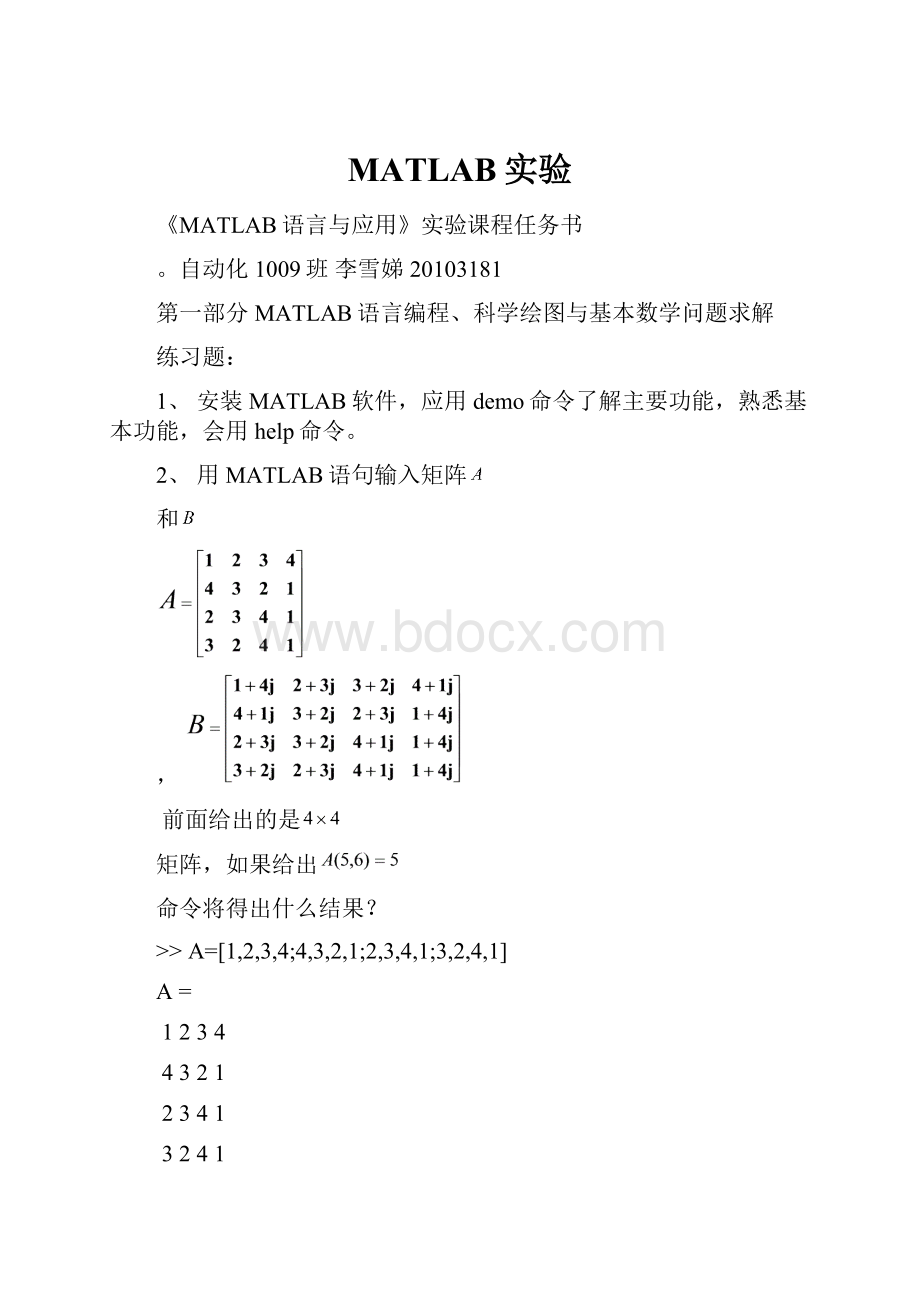MATLAB实验.docx
《MATLAB实验.docx》由会员分享,可在线阅读,更多相关《MATLAB实验.docx(37页珍藏版)》请在冰豆网上搜索。

MATLAB实验
《MATLAB语言与应用》实验课程任务书
。
自动化1009班李雪娣20103181
第一部分MATLAB语言编程、科学绘图与基本数学问题求解
练习题:
1、安装MATLAB软件,应用demo命令了解主要功能,熟悉基本功能,会用help命令。
2、用MATLAB语句输入矩阵
和
,
前面给出的是
矩阵,如果给出
命令将得出什么结果?
>>A=[1,2,3,4;4,3,2,1;2,3,4,1;3,2,4,1]
A=
1234
4321
2341
3241
>>B=[1+4j,2+3j,3+2j,4+1j;4+1j,3+2j,2+3j,1+4j;2+3j,3+2j,4+1j,1+4j;3+2j,2+3j,4+1j,1+4j]
B=
1.0000+4.0000i2.0000+3.0000i3.0000+2.0000i4.0000+1.0000i
4.0000+1.0000i3.0000+2.0000i2.0000+3.0000i1.0000+4.0000i
2.0000+3.0000i3.0000+2.0000i4.0000+1.0000i1.0000+4.0000i
3.0000+2.0000i2.0000+3.0000i4.0000+1.0000i1.0000+4.0000i
>>A(5,6)=5
A=
123400
432100
234100
324100
000005
3、假设已知矩阵
,试给出相应的MATLAB命令,将其全部偶数行提取出来,赋给
矩阵,用
命令生成
矩阵,用上述命令检验一下结果是不是正确。
>>A=magic(8)
A=
642361606757
955541213515016
1747462021434224
4026273736303133
3234352928383925
4123224445191848
4915145253111056
858595462631
>>B=A(2:
2:
end,:
)
B=
955541213515016
4026273736303133
4123224445191848
858595462631
4、用数值方法可以求出
,试不采用循环的形式求出和式的数值解。
由于数值方法是采用double形式进行计算的,难以保证有效位数字,所以结果不一定精确。
试采用运算的方法求该和式的精确值。
>>i=0:
63;s=sum(2.^i)
s=
1.8447e+019
>>symsk;symsum(2^k,0,63)
ans=
184********709551615
5、选择合适的步距绘制出下面的图形。
(1)
,其中
;
(2)
,其中
。
(1)>>t=[-1:
0.001:
1];
y=sin(1./t);
plot(t,y)
(2)>>t=[-pi:
0.05:
-1.8,-1.8:
0.001:
-1.2,-1.2:
0.05:
1.2,1.2:
0.001:
1.8,1.8:
0.05:
pi];
y=sin(tan(t))-tan(sin(t));
plot(t,y)
6、试绘制出二元函数
的三维图和三视图。
>>x1=[-2:
0.1:
-1.2,-1.1:
0.02:
-0.9,-0.8:
0.1:
0.8,0.9:
0.02:
1.1,1.2:
0.1:
2];
y1=[-1:
0.1:
-0.2,-0.1:
0.02:
0.1,0.2:
0.1:
1];
[x,y]=meshgrid(x1,y1);
z=1./sqrt((1-x).^2+y.^2)+1./sqrt((1+x).^2+y.^2);
surf(x,y,z),shadingflat;
>>subplot(224);surf(x,y,z);shadingflat;title('正视图');
subplot(223);surf(x,y,z);shadingflat;view(0,0);title('右视图');
subplot(221);surf(x,y,z);shadingflat;view(90,0);title('左视图');
subplot(222);surf(x,y,z);shadingflat;view(0,90);title('俯视图');
7、试求出如下极限。
(1)
;
(2)
;(3)
。
(1)>>symsx;f=(3^x+9^x)^(1/x);limit(f,x,inf)
ans=
9
(2)>>symsxy;f=(x*y)/(sqrt(x*y+1)-1);limit(limit(f,x,0),y,0)
ans=
2
(3)>>symsxy;f=(1-cos(x.^2+y.^2))/(x.^2+y.^2).*exp(x.^2+y.^2);limit(limit(f,x,0),y,0)
ans=
0
8、已知参数方程
,试求出
和
。
>>symst;x=log(cos(t));y=cos(t)-t*sin(t);
diff(y,t)/diff(x,t)
ans=
(cos(t)*(2*sin(t)+t*cos(t)))/sin(t)
>>f1=(cos(t)*(2*sin(t)+t*cos(t)))/sin(t);
f2=diff(f1,t)/diff(x,t);
subs(f2,t,pi/3)
ans=
1.5387
9、假设
,试求
。
>>symsxyt;
f=int(exp(-t^2),t,0,x*y);
x/y*diff(f,x,2)-2*diff(diff(f,x),y)+diff(f,y,2)
ans=
2*x^2*y^2*exp(-x^2*y^2)-2*x^3*y*exp(-x^2*y^2)-2*exp(-x^2*y^2)
>>simple(ans)
ans=
-2*exp(-x^2*y^2)*(x^3*y-x^2*y^2+1)
10、试求出下面的极限。
(1)
;
(2)
。
(1)>>symsn;
limit(symsum(1/((2*n)^2-1),n,1,inf),n,inf)
ans=
1/2
(2)>>symsnm;limit(n*symsum(1/(n^2+pi*m),m,1,n),n,inf)
ans=
1
11、试求出以下的曲线积分。
(1)
,
为曲线
,
,
。
(2)
,其中
为
正向上半椭圆。
(1)>>symst;symsapositive;
x=a*(cos(t)+t*sin(t));
y=a*(sin(t)-t*cos(t));
int((x^2+y^2)*sqrt(diff(x,t)^2+diff(y,t)^2),t,0,2*pi)
ans=
2*pi^2*a^3*(2*pi^2+1)
>>simple(ans)
ans=
pi^2*a^3*(4*pi^2+2)
(2)>>symst;symsabcpositive;
x=a/c*cos(t);y=b/c*sin(t);
P=y*x^3+exp(y);
Q=x*y^3+x*exp(y)-2*y;
ds=[diff(x,t);diff(y,t)];
I=int([PQ]*ds,t,0,pi)
I=
(2*a*(2*b^4-15*c^4))/(15*c^5)
12、试求出Vandermonde矩阵
的行列式,并以最简的形式显示结果。
>>symsabcde;
A=[a^4,a^3,a^2,a,1;b^4,b^3,b^2,b,1;c^4,c^3,c^2,c,1;d^4,d^3,d^2,d,1;e^4,e^3,e^2,e,1];
det(A)
ans=
a^4*b^3*c^2*d-a^4*b^3*c^2*e-a^4*b^3*c*d^2+a^4*b^3*c*e^2+a^4*b^3*d^2*e-a^4*b^3*d*e^2-a^4*b^2*c^3*d+a^4*b^2*c^3*e+a^4*b^2*c*d^3-a^4*b^2*c*e^3-a^4*b^2*d^3*e+a^4*b^2*d*e^3+a^4*b*c^3*d^2-a^4*b*c^3*e^2-a^4*b*c^2*d^3+a^4*b*c^2*e^3+a^4*b*d^3*e^2-a^4*b*d^2*e^3-a^4*c^3*d^2*e+a^4*c^3*d*e^2+a^4*c^2*d^3*e-a^4*c^2*d*e^3-a^4*c*d^3*e^2+a^4*c*d^2*e^3-a^3*b^4*c^2*d+a^3*b^4*c^2*e+a^3*b^4*c*d^2-a^3*b^4*c*e^2-a^3*b^4*d^2*e+a^3*b^4*d*e^2+a^3*b^2*c^4*d-a^3*b^2*c^4*e-a^3*b^2*c*d^4+a^3*b^2*c*e^4+a^3*b^2*d^4*e-a^3*b^2*d*e^4-a^3*b*c^4*d^2+a^3*b*c^4*e^2+a^3*b*c^2*d^4-a^3*b*c^2*e^4-a^3*b*d^4*e^2+a^3*b*d^2*e^4+a^3*c^4*d^2*e-a^3*c^4*d*e^2-a^3*c^2*d^4*e+a^3*c^2*d*e^4+a^3*c*d^4*e^2-a^3*c*d^2*e^4+a^2*b^4*c^3*d-a^2*b^4*c^3*e-a^2*b^4*c*d^3+a^2*b^4*c*e^3+a^2*b^4*d^3*e-a^2*b^4*d*e^3-a^2*b^3*c^4*d+a^2*b^3*c^4*e+a^2*b^3*c*d^4-a^2*b^3*c*e^4-a^2*b^3*d^4*e+a^2*b^3*d*e^4+a^2*b*c^4*d^3-a^2*b*c^4*e^3-a^2*b*c^3*d^4+a^2*b*c^3*e^4+a^2*b*d^4*e^3-a^2*b*d^3*e^4-a^2*c^4*d^3*e+a^2*c^4*d*e^3+a^2*c^3*d^4*e-a^2*c^3*d*e^4-a^2*c*d^4*e^3+a^2*c*d^3*e^4-a*b^4*c^3*d^2+a*b^4*c^3*e^2+a*b^4*c^2*d^3-a*b^4*c^2*e^3-a*b^4*d^3*e^2+a*b^4*d^2*e^3+a*b^3*c^4*d^2-a*b^3*c^4*e^2-a*b^3*c^2*d^4+a*b^3*c^2*e^4+a*b^3*d^4*e^2-a*b^3*d^2*e^4-a*b^2*c^4*d^3+a*b^2*c^4*e^3+a*b^2*c^3*d^4-a*b^2*c^3*e^4-a*b^2*d^4*e^3+a*b^2*d^3*e^4+a*c^4*d^3*e^2-a*c^4*d^2*e^3-a*c^3*d^4*e^2+a*c^3*d^2*e^4+a*c^2*d^4*e^3-a*c^2*d^3*e^4+b^4*c^3*d^2*e-b^4*c^3*d*e^2-b^4*c^2*d^3*e+b^4*c^2*d*e^3+b^4*c*d^3*e^2-b^4*c*d^2*e^3-b^3*c^4*d^2*e+b^3*c^4*d*e^2+b^3*c^2*d^4*e-b^3*c^2*d*e^4-b^3*c*d^4*e^2+b^3*c*d^2*e^4+b^2*c^4*d^3*e-b^2*c^4*d*e^3-b^2*c^3*d^4*e+b^2*c^3*d*e^4+b^2*c*d^4*e^3-b^2*c*d^3*e^4-b*c^4*d^3*e^2+b*c^4*d^2*e^3+b*c^3*d^4*e^2-b*c^3*d^2*e^4-b*c^2*d^4*e^3+b*c^2*d^3*e^4
>>simple(det(A))
ans=
(a-b)*(a-c)*(a-d)*(b-c)*(a-e)*(b-d)*(b-e)*(c-d)*(c-e)*(d-e)
13、试对矩阵
进行Jordan变换,并得出变换矩阵。
>>A=[-20.5-0.50.5;0-1.50.5-0.5;2,0.5-4.50.5;21,-2,-2];
[V,J]=jordan(sym(A))
V=
[0,1/2,1/2,-1/4]
[0,0,1/2,1]
[1/4,1/2,1/2,-1/4]
[1/4,1/2,1,-1/4]
J=
[-4,0,0,0]
[0,-2,1,0]
[0,0,-2,1]
[0,0,0,-2]
14、试用数值方法和解析方法求取下面的Sylvester方程,并验证得出的结果。
>>A=[3-6-405;142-24;-63-673;-13100-110;04034];
B=[3-21;-2-92;-2-19];
C=[2-11;-4-1-2;-56-1;-644;6-63];
数值方法:
X=lyap(A,B,C)
X=
4.056914.5128-1.5653
-0.0356-25.07432.7408
-9.4886-25.93234.4177
-2.6969-21.64502.8851
-7.7229-31.91003.7634
>>norm(A*X+X*B+C)
ans=
4.3904e-13
解析解>>A=sym(A);X=lyap(A,B,C)
X=
4.056914.5128-1.5653
-0.0356-25.07432.7408
-9.4886-25.93234.4177
-2.6969-21.64502.8851
-7.7229-31.91003.7634
>>norm(double(A*X+X*B+C))
ans=
4.3904e-13
解析解与实际不符
15、假设已知矩阵
如下,试求出
,
,
。
(1)>>A=[-4.5,0,0.5,-1.5;-0.5,-4,0.5,-0.5;1.5,1,-2.5,1.5;0,-1,-1,-3];
symst;simple(expm(A*t))
ans=
[(exp(-5*t)*(exp(2*t)-t*exp(2*t)+t^2*exp(2*t)+1))/2,(exp(-5*t)*(2*t*exp(2*t)-exp(2*t)+1))/2,(t*exp(-3*t)*(t+1))/2,-(exp(-5*t)*(exp(2*t)+t*exp(2*t)-t^2*exp(2*t)-1))/2]
[(exp(-5*t)*(t*exp(2*t)-exp(2*t)+1))/2,(exp(-5*t)*(exp(2*t)+1))/2,(t*exp(-3*t))/2,(exp(-5*t)*(t*exp(2*t)-exp(2*t)+1))/2]
[(exp(-5*t)*(exp(2*t)+t*exp(2*t)-1))/2,(exp(-5*t)*(exp(2*t)-1))/2,(exp(-3*t)*(t+2))/2,(exp(-5*t)*(exp(2*t)+t*exp(2*t)-1))/2]
[-(t^2*exp(-3*t))/2,-t*exp(-3*t),-(t*exp(-3*t)*(t+2))/2,-(exp(-3*t)*(t^2-2))/2]
(2)>>A=[-4.5,0,0.5,-1.5;-0.5,-4,0.5,-0.5;1.5,1,-2.5,1.5;0,-1,-1,-3];
A=sym(A);symst;simple(sin(A*t))
ans=
[-sin((9*t)/2),0,sin(t/2),-sin((3*t)/2)]
[-sin(t/2),-sin(4*t),sin(t/2),-sin(t/2)]
[sin((3*t)/2),sin(t),-sin((5*t)/2),sin((3*t)/2)]
[0,-sin(t),-sin(t),-sin(3*t)]
(3)>>A=[-4.5,0,0.5,-1.5;-0.5,-4,0.5,-0.5;1.5,1,-2.5,1.5;0,-1,-1,-3];
A=sym(A);symst;exp(A*t)*sin(A^2*exp(A*t)*t)
ans=
[sin(t*(17*exp(-t/2)-3*exp((3*t)/2)+5*exp(-(9*t)/2)+5))+exp(-(3*t)/2)*sin(t*(6*exp(-t/2)+5*exp((3*t)/2)-exp(-(9*t)/2)+8))-exp(t/2)*sin(t*(8*exp(-t/2)-6*exp((3*t)/2)+11*exp(-(9*t)/2)+11))+exp(-(9*t)/2)*sin(t*(2*exp(-t/2)-2*exp((3*t)/2)+21*exp(-(9*t)/2)+12)),sin(t*(5*exp(-t)+17*exp(-4*t)-3*exp(t)+5))+sin(t*(8*exp(-t)+6*exp(-4*t)+5*exp(t)-1))*exp(-(3*t)/2)-sin(t*(11*exp(-t)+8*exp(-4*t)-6*exp(t)+11))*exp(t/2)+sin(t*(12*exp(-t)+2*exp(-4*t)-2*exp(t)+21))*exp(-(9*t)/2),sin(t*(5*exp(-t)+22*exp(t/2)-3*exp(-(5*t)/2)))+exp(-(3*t)/2)*sin(t*(8*exp(-t)+5*exp(t/2)+5*exp(-(5*t)/2)))-exp(t/2)*sin(t*(11*exp(-t)+19*exp(t/2)-6*exp(-(5*t)/2)))+exp(-(9*t)/2)*sin(t*(12*exp(-t)+23*exp(t/2)-2*exp(-(5*t)/2))),sin(t*(5*exp(-3*t)+17*exp(-t/2)+5*exp(-(3*t)/2)-3*exp((3*t)/2)))+sin(t*(8*exp(-3*t)+6*exp(-t/2)-exp(-(3*t)/2)+5*exp((3*t)/2)))*exp(-(3*t)/2)-sin(t*(11*exp(-3*t)+8*exp(-t/2)+11*exp(-(3*t)/2)-6*exp((3*t)/2)))*exp(t/2)+sin(t*(12*exp(-3*t)+2*exp(-t/2)+21*exp(-(3*t)/2)-2*exp((3*t)/2)))*exp(-(9*t)/2)]
[exp(-t/2)*sin(t*(6*exp(-t/2)+5*exp((3*t)/2)-exp(-(9*t)/2)+8))+exp(-4*t)*sin(t*(17*exp(-t/2)-3*exp((3*t)/2)+5*exp(-(9*t)/2)+5))-exp(t/2)*sin(t*(8*exp(-t/2)-6*exp((3*t)/2)+11*exp(-(9*t)/2)+11))+exp(-t/2)*sin(t*(2*exp(-t/2)-2*exp((3*t)/2)+21*exp(-(9*t)/2)+12)),sin(t*(8*exp(-t)+6*exp(-4*t)+5*exp(t)-1))*exp(-t/2)+sin(t*(5*exp(-t)+17*exp(-4*t)-3*exp(t)+5))*exp(-4*t)-sin(t*(11*exp(-t)+8*exp(-4*t)-6*exp(t)+11))*exp(t/2)+sin(t*(12*exp(-t)+2*exp(-4*t)-2*exp(t)+21))*exp(-t/2),exp(-t/2)*sin(t*(8*exp(-t)+5*exp(t/2)+5*exp(-(5*t)/2)))+exp(-4*t)*sin(t*(5*exp(-t)+22*exp(t/2)-3*exp(-(5*t)/2)))-exp(t/2)*sin(t*(11*exp(-t)+19*exp(t/2)-6*exp(-(5*t)/2)))+exp(-t/2)*sin(t*(12*exp(-t)+23*exp(t/2)-2*exp(-(5*t)/2))),sin(t*(8*exp(-3*t)+6*exp(-t/2)-exp(-(3*t)/2)+5*exp((3*t)/2)))*exp(-t/2)+sin(t*(5*exp(-3*t)+17*exp(-t/2)+5*exp(-(3*t)/2)-3*exp((3*t)/2)))*exp(-4*t)-sin(t*(11*exp(-3*t)+8*exp(-t/2)+11*exp(-(3*t)/2)-6*exp((3*t)/2)))*exp(t/2)+sin(t*(12*exp(-3*t)+2*exp(-t/2)+21*exp(-(3*t)/2)-2*exp((3*t)/2)))*exp(-t/2)]
[exp((3*t)/2)*sin(t*(6*exp(-t/2)+